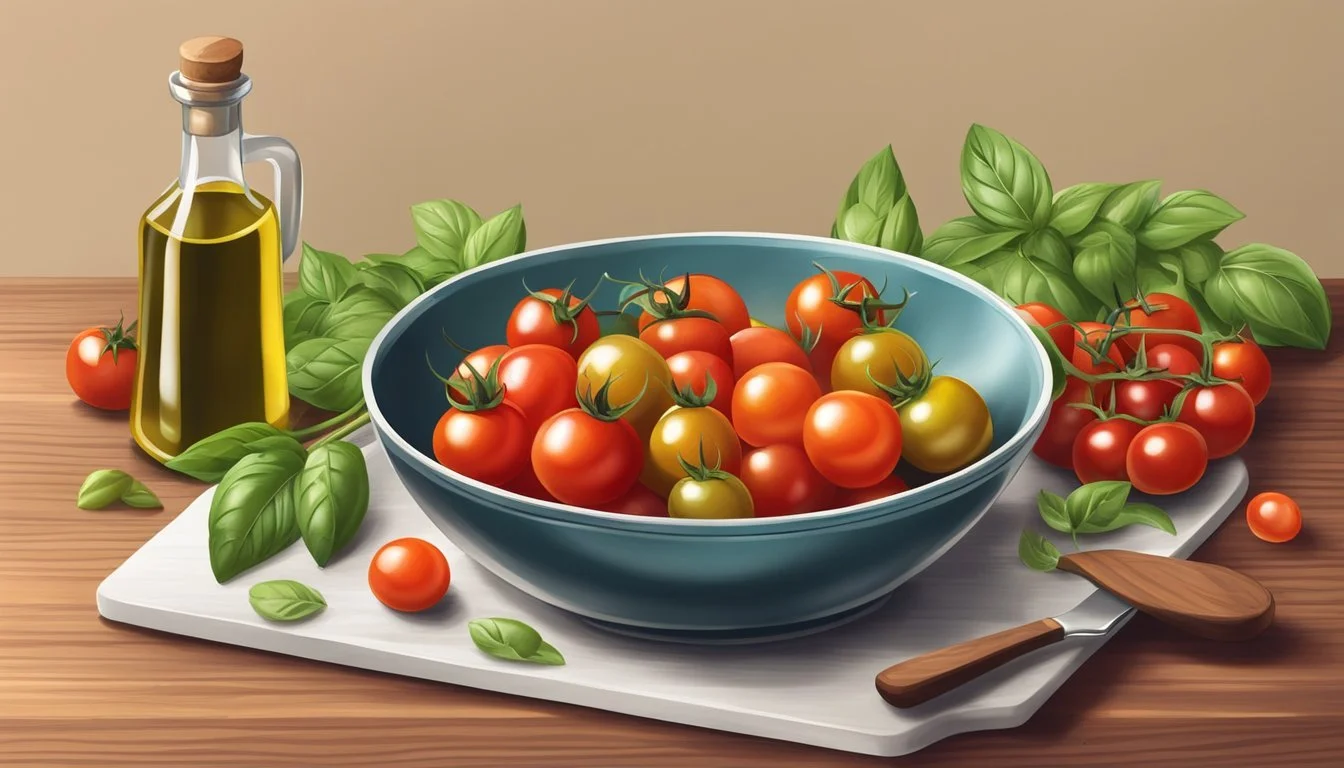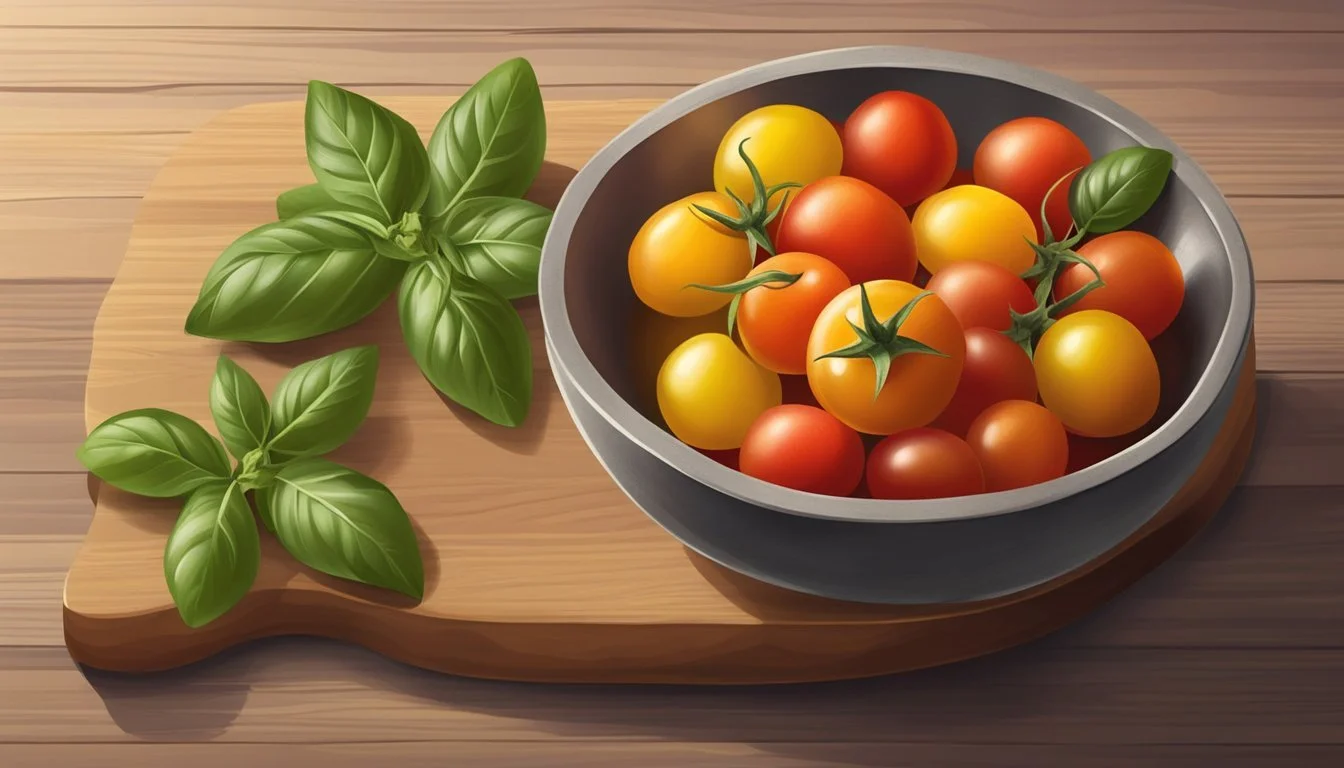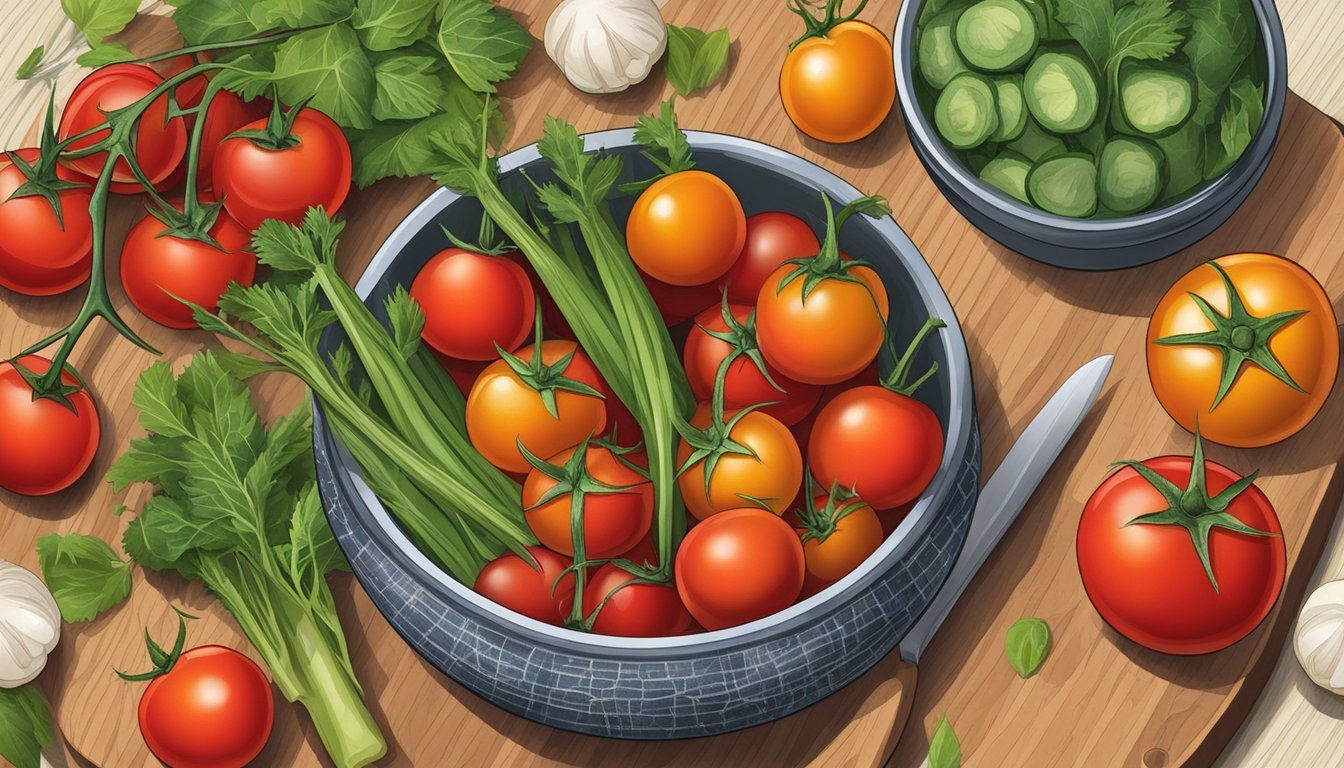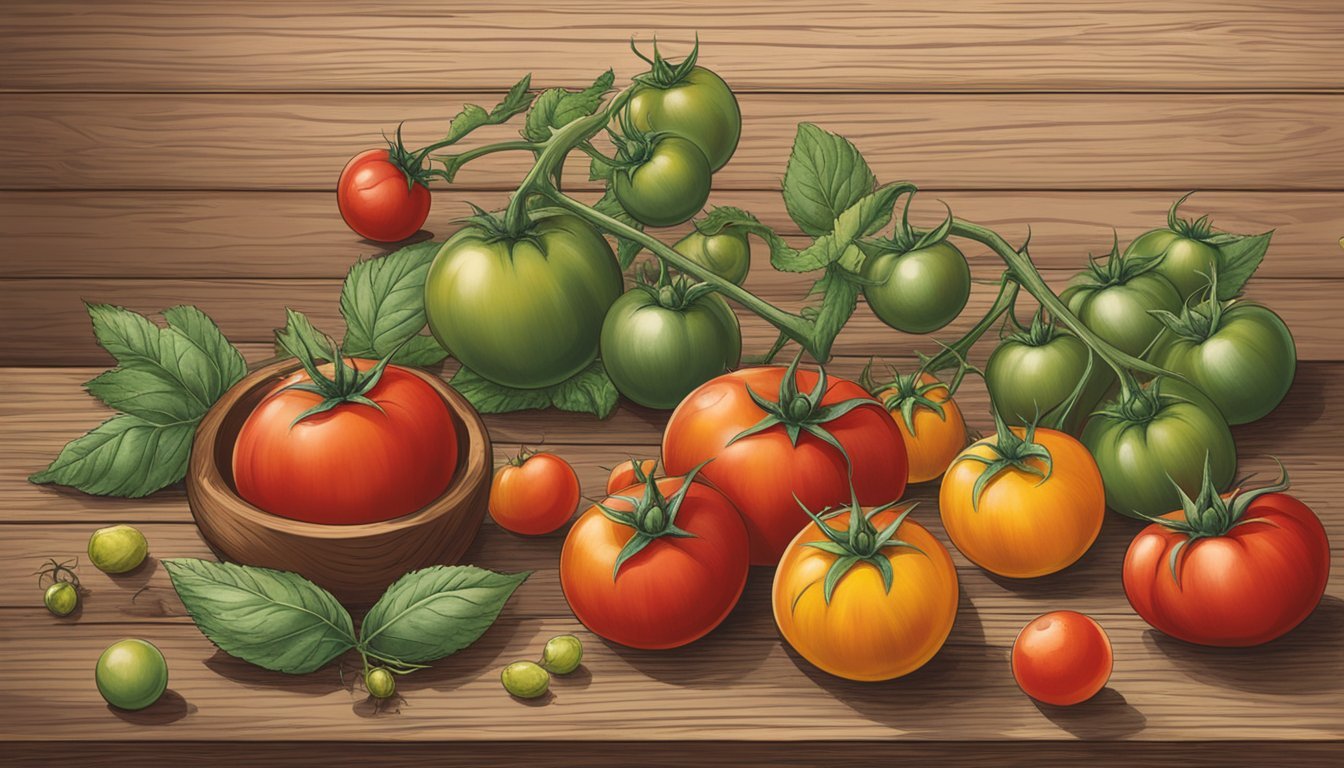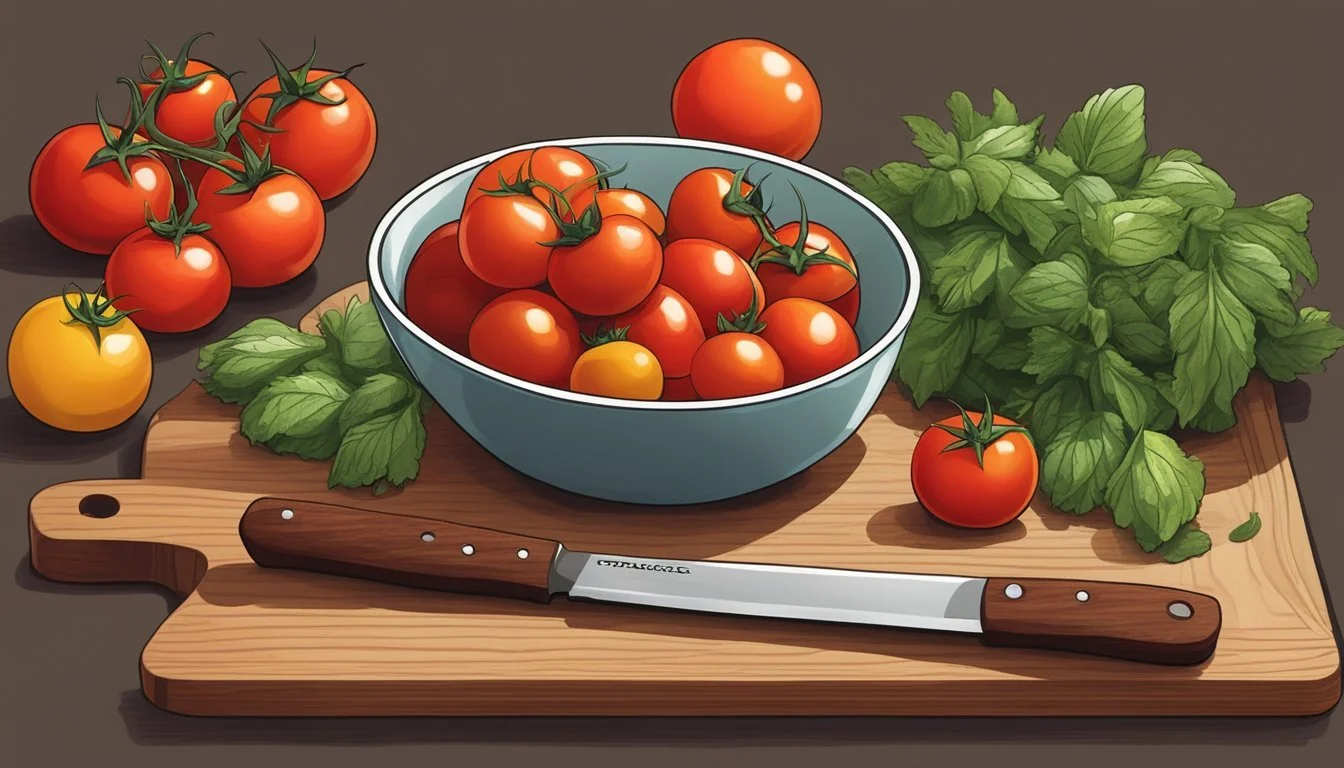Cherry Tomatoes Substitutes
Top Alternatives for Your Recipes
Cherry tomatoes are a staple in many kitchens, prized for their sweet flavor and versatility in a variety of recipes. However, there are times when you might need a substitute. Grape tomatoes are an excellent alternative, closely mimicking the size and flavor of cherry tomatoes, making them perfect for salads, pasta dishes, and more.
For those looking for a richer, more concentrated taste, sun-dried tomatoes make a fantastic substitute. Their intense flavor and chewy texture can elevate casseroles and other hearty dishes. Another viable option is Campari tomatoes, known for their juiciness and balanced sweetness, fitting seamlessly into sandwiches and salads.
Red bell peppers can also step in when you're in a pinch. They offer a hint of sweetness and a similar color, although their flavor profile is slightly different. Regardless of the substitute you choose, each brings its unique twist to your favorite recipes.
Understanding the Basics
Cherry tomatoes are a favorite in many dishes due to their sweet flavor, small size, and vibrant color. This section explores their key characteristics and their significance in culinary uses.
Characteristics of Cherry Tomatoes
Cherry tomatoes are small, round, and typically bright red or yellow.
They usually range from 1 to 2 inches in diameter.
Flavor: They are known for their sweet and slightly tangy taste, which makes them a delightful addition to various dishes.
Texture: They have a juicy interior that adds a fresh and succulent texture to meals.
Despite their diminutive size, they are packed with flavor. These tomatoes are often sweeter than larger varieties like beefsteak tomatoes.
The high ratio of skin to flesh gives them a nice snap when bitten into, which is different from larger, meatier tomatoes.
Importance in Culinary Applications
Cherry tomatoes are versatile in cooking and are used in a plethora of dishes.
Salads: Their small size, sweetness, and visual appeal make them ideal for salads. They can be used whole or halved.
Cooking: They retain their shape and flavor when cooked, making them perfect for roasting, grilling, and even baking.
They are commonly used in sauces, where their sweetness balances acidity.
Snacking: Due to their bite-sized form and sweet taste, they are also popular as a healthy snack.
Their vibrant color and sweet flavor add visual and taste appeal to many dishes, making them a staple in both home kitchens and restaurants.
Common Cherry Tomato Substitutes
Cherry tomatoes have several substitutes that can effectively replace them in various recipes. The key factors to consider are texture, flavor, and how these substitutes will complement your dish.
Grape Tomatoes
Grape tomatoes share a similar size and sweetness with cherry tomatoes. They have a firm texture, making them excellent for salads, pasta dishes, and bruschetta. While they are slightly less juicy, their thick skin provides a satisfying bite.
Texture: Firm, holds up well in cooking
Flavor: Sweet, but slightly less juicy than cherry tomatoes
Usage: Ideal for salads, pasta, and as a topping for bruschetta
Campari Tomatoes
Campari tomatoes are larger than cherry tomatoes but offer a comparable sweetness and low acidity. They're less watery, making them perfect for dishes where you want a more substantial tomato presence without excess liquid.
Texture: Juicy, with low water content
Flavor: Sweet, with low acidity
Usage: Suitable for salads, sandwiches, and cooking where a meatier texture is preferred
Plum Tomatoes
Plum tomatoes, or Roma tomatoes, are elongated and have fleshy interiors ideal for sauces and cooked dishes. Their lower water content and thicker flesh mean they hold up well during cooking without becoming too mushy.
Texture: Thick and fleshy, less water content
Flavor: Mild sweetness, slightly earthy
Usage: Perfect for sauces, stews, and slow-cooked recipes
Canned Tomatoes
Canned tomatoes are a versatile substitute, especially in cooked dishes. They come peeled and sometimes pre-seasoned, saving preparation time. Canned tomatoes work well in soups, stews, and sauces where fresh tomato texture is less critical.
Texture: Soft, often pre-peeled and chopped
Flavor: Varies (whole, diced, or crushed)
Usage: Best for soups, stews, and sauces where a smooth consistency is desired
Substitutes Based on Dish Type
Finding the right substitute for cherry tomatoes can depend greatly on the type of dish you are preparing. Here are the best alternatives categorized by salads, pasta and sauces, sandwiches and wraps, and baked and roasted dishes.
For Salads
When replacing cherry tomatoes in salads, grape tomatoes are an excellent choice. They offer a similarly sweet and tangy flavor in a small, bite-sized form.
Another great option is Campari tomatoes. These are slightly larger but can be chopped to a similar size. They are known for their juiciness and balanced sweetness, making them a wonderful alternative.
For a burst of savory flavor, ripe olives can be used, providing a unique salty twist and soft texture.
For Pasta and Sauces
In pasta dishes and sauces, plum tomatoes work particularly well. Their dense flesh and low water content provide a rich texture that blends seamlessly into sauces like marinara or bolognese.
Sun-dried tomatoes are also a fantastic substitute due to their intense, concentrated flavor. They excel when cooked down in sauces, adding a profound depth of taste.
Canned tomatoes, whether whole or diced, are practical alternatives. They are convenient and available year-round, offering a consistent flavor profile for various pasta sauces.
For Sandwiches and Wraps
Grape tomatoes shine in sandwiches and wraps where a sweet, tangy burst is desirable. Their small size and firm texture prevent them from turning mushy, maintaining the sandwich's structural integrity.
Campari tomatoes, when sliced thin, fit well within sandwiches and wraps, adding moisture and a balanced flavor. Their slightly larger size compared to cherry tomatoes is easily adjustable by slicing thinner.
When cherry tomatoes are unavailable, red bell peppers can be used. They provide a crunchy, sweet alternative while mimicking the visual appeal with their vibrant red color.
For Baked and Roasted Dishes
For baked and roasted dishes, using Roma tomatoes is beneficial. They hold up well under heat and offer a meaty texture that complements dishes like roasted vegetables or casseroles.
Plum tomatoes, known for their dense flesh, are another excellent choice, especially in recipes requiring a robust tomato flavor without turning watery during cooking.
Sun-dried tomatoes can add complexity to baked dishes with their rich taste. They integrate well into baked casseroles, pizza toppings, or even roasted vegetable medleys.
Fruit and Vegetable Substitutes
Cherry tomatoes can be substituted by various fruits and vegetables which offer unique flavors and textures suitable for different types of recipes. Some of the best options include red bell peppers, mango, zucchini, and a combination of pumpkin and carrots.
Red Bell Peppers
Red bell peppers are an excellent substitute for cherry tomatoes due to their vibrant color and sweet, crisp flavor. They provide a similar visual appeal and can be used in salads, salsas, and stir-fries.
Their high water content and crisp texture make them a refreshing addition to any dish. To match the size and shape of cherry tomatoes, red bell peppers can be chopped into small dice or thin strips.
Mango
Mango brings a unique sweetness and soft texture, making it a versatile substitute for cherry tomatoes in salads and salsas. The juiciness of a ripe mango complements the tangy flavors often found in these dishes.
When substituting, cubed or thinly sliced mango can add a sweet and tropical note, offering a pleasing contrast to other, more savory ingredients. This works particularly well in dishes that benefit from a touch of sweetness.
Zucchini
Zucchini, while less sweet than cherry tomatoes, offers a mild flavor and firm texture that fits well in many recipes. It works wonderfully in cooked dishes such as casseroles, stir-fries, and stews.
Thinly slicing or dicing zucchini to a size similar to cherry tomatoes can help maintain the consistency and appearance of the dish. For raw applications, lightly salting zucchini can enhance its flavor and texture.
Pumpkin and Carrots
Pumpkin and carrots can be combined to offer a rich and hearty substitute. The earthy sweetness of carrots paired with the mild flavor and creamy texture of pumpkin make for a delicious alternative in soups, stews, and baked dishes.
To substitute, dice both pumpkin and carrots into small, cherry tomato-sized pieces. This combination works particularly well in fall recipes or dishes where a deeper flavor profile is desired. Cooking both together until tender enhances their flavors.
Specialty Tomato Varieties
Specialty tomato varieties offer unique flavors, colors, and textures that can add interest and depth to any dish. This section explores three distinct types: currant tomatoes, heirloom tomatoes, and red pear tomatoes.
Currant Tomatoes
Currant tomatoes are tiny, often no larger than a small marble. Despite their size, they pack a punch of rich, sweet flavor. These tiny tomatoes are ideal for garnishing dishes or adding a pop of color to salads. They grow in clusters and are typically red or yellow when ripe. Due to their size and delicate nature, they are best enjoyed fresh rather than cooked. Their diminutive size also makes them perfect for snacking or using in dishes where a burst of sweetness is desirable.
Heirloom Tomatoes
Heirloom tomatoes encompass a wide range of varieties, each with its unique taste, shape, and color. They are often prized for their superior flavor, compared to hybrid varieties. Common heirloom types include Brandywine, Cherokee Purple, and Green Zebra. These tomatoes are not only flavorful but also visually striking, often featuring unique colors and patterns. Heirloom tomatoes are open-pollinated, meaning they are grown from seeds that have been passed down through generations. This preserves their distinct characteristics and contributes to a diverse genetic pool. They can be used in sandwiches, salads, or simply enjoyed on their own with a touch of salt.
Red Pear Tomatoes
Red pear tomatoes are small, pear-shaped tomatoes that are bright red in color. They offer a balance of sweetness and acidity, making them versatile for various culinary uses. These tomatoes are particularly popular in salads and can also be used in sauces or roasted. Their unique shape and vibrant color make them an attractive addition to any dish. Red pear tomatoes grow in clusters on the vine, similar to grape tomatoes, making them easy to harvest. They have a smooth texture and can be eaten whole, sliced, or chopped, depending on the dish requirements.
Non-Tomato Substitutes
When cherry tomatoes are unavailable or unwanted, there are several excellent non-tomato substitutes. Each option offers distinct flavors and textures, creating opportunities to preserve the essence of your dishes.
Olives for Savory Flavors
Olives bring a rich, salty depth perfect for enhancing various recipes. Black or ripe olives, in particular, offer a robust, savory flavor that can replace cherry tomatoes in salads and Mediterranean dishes.
Replace 1 cup of cherry tomatoes with 1/2 cup of halved ripe olives. The dark color and unique taste of olives provide a delightful twist, making them a versatile choice for many dishes requiring a burst of savoriness.
Tamarind Paste for Sweet and Tangy Notes
Tamarind paste introduces a sweet and tangy profile suitable for recipes needing a flavor punch without tomatoes. It comes from the tamarind fruit and is common in Asian and Indian cuisines.
Use tamarind paste in stews, soups, and marinades to replace the tanginess of tomatoes. A teaspoon-to-teaspoon ratio can be a good starting point, adjusting to taste based on the dish’s requirements.
Eggplant for Texture
Eggplant offers a firm yet tender texture that can mimic the mouthfeel of cherry tomatoes. It's an adaptable vegetable that absorbs flavors well, making it a practical tomato substitute in cooked dishes like ratatouille or pasta sauces.
Cube or slice the eggplant, then sauté or roast before adding it to recipes. Its neutral taste and satisfying texture make it an effective replacement, especially for those avoiding tomatoes.
Bilimbi in Tropical Cuisines
Bilimbi, a small tropical fruit, provides a sour flavor and crisp texture often used in Southeast Asian cuisines. It resembles a cucumber but delivers a tartness that can substitute for the acidity of cherry tomatoes in curries and chutneys.
Use bilimbi in recipes where a tangy element is essential. They can be sliced thin and added directly to dishes, providing the needed zest while keeping the tropical authenticity in cuisine.
Considerations for Substitutes
When substituting for cherry tomatoes, it is crucial to consider factors such as sweetness and acidity, texture and juiciness, and potential dietary restrictions.
Adjusting Sweetness and Acidity
Cherry tomatoes are known for their balanced sweetness and acidity. Replacing them requires attention to these flavor profiles. For example, grape tomatoes can be used as they have a similar taste. Campari tomatoes offer a slightly sweeter and juicier option compared to cherry tomatoes.
Conversely, sun-dried tomatoes provide an intense, concentrated flavor, with a higher level of sweetness and acidity due to their drying process, making them suitable for dishes that call for bolder flavors. Combining different types of tomatoes or adjusting the amount used can help maintain the desired balance in your dishes.
Texture and Juiciness Considerations
The texture and juiciness of cherry tomatoes make them popular in various dishes. Grape tomatoes are firmer and have less water content, which may alter the consistency of salads and salsas. Campari tomatoes, being juicier, can substitute well in recipes that benefit from a more succulent texture, such as quiches and pizzas.
Sun-dried tomatoes present a chewy texture, suitable for casseroles and baked dishes, but can change the dish's overall mouthfeel if used excessively. Proper hydration or combining with fresh tomatoes can mitigate these textural changes while enhancing the dish.
Allergies and Dietary Restrictions
When choosing substitutes, consider potential allergens and dietary restrictions. While tomatoes generally do not contain common allergens, some individuals may have specific sensitivities. Always verify alternatives for additional ingredients that might cause allergies.
For those watching their sodium intake, it's essential to consider that sun-dried tomatoes often come packed with salt to preserve them. Thus, they may not be suitable for a low-sodium diet. Additionally, cross-contact with allergens in processing facilities is a factor to consider, especially with pre-packaged tomato products. Choosing fresh alternatives can help mitigate these risks.
Where to Find Substitutes
Finding substitutes for cherry tomatoes can be straightforward if you know where to look. Grocery stores often stock a variety of alternatives, while home gardens can be an excellent source for fresh, easily accessible substitutes.
Grocery Store Options
In grocery stores, substitutes for cherry tomatoes are usually abundant. Grape tomatoes are a popular choice due to their similar size and sweetness. Look for them in the produce aisle next to other small tomato varieties.
Plum tomatoes are another option. While larger, they can be diced to match the size of cherry tomatoes. Campari tomatoes are smaller than plum tomatoes but maintain a good balance of sweetness and acidity.
Canned tomatoes can be a convenient alternative. If fresh options are unavailable, canned cherry tomatoes or diced tomatoes can seamlessly integrate into your recipes. Sun-dried tomatoes are available in most stores and offer a concentrated flavor ideal for salads and salsas.
Home Garden Alternatives
Home gardens provide a variety of options for substitutes. If cherry tomatoes are not available, small heirloom tomatoes can be a great substitute. They offer unique flavors and vibrant colors to your dishes.
Grape tomatoes are easy to cultivate and can replace cherry tomatoes in any recipe. Given their similar growth requirements, they thrive in the same conditions as cherry tomatoes.
Growing peppers like red bell peppers can provide a sweet and crunchy substitute. While not a tomato, their robust flavor and texture can be a delightful alternative in many dishes. Small cucumbers are another versatile option to grow, especially for fresh salads and cold dishes.
Lastly, herbs such as basil can complement other substitutes, adding a fragrant touch to your recipes. They are simple to grow and can thrive alongside any other vegetables in your garden.

